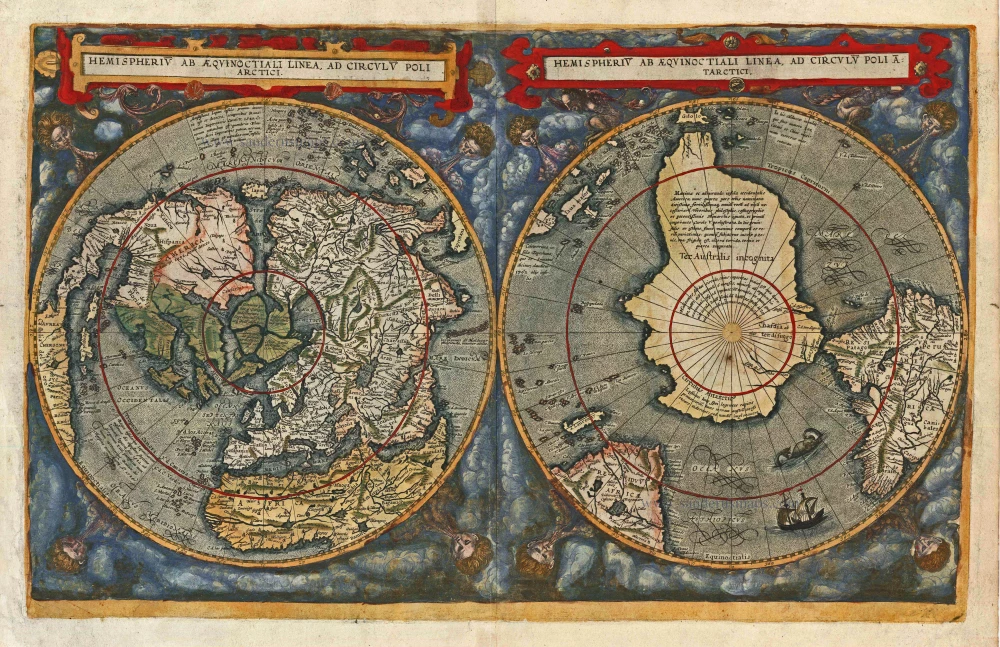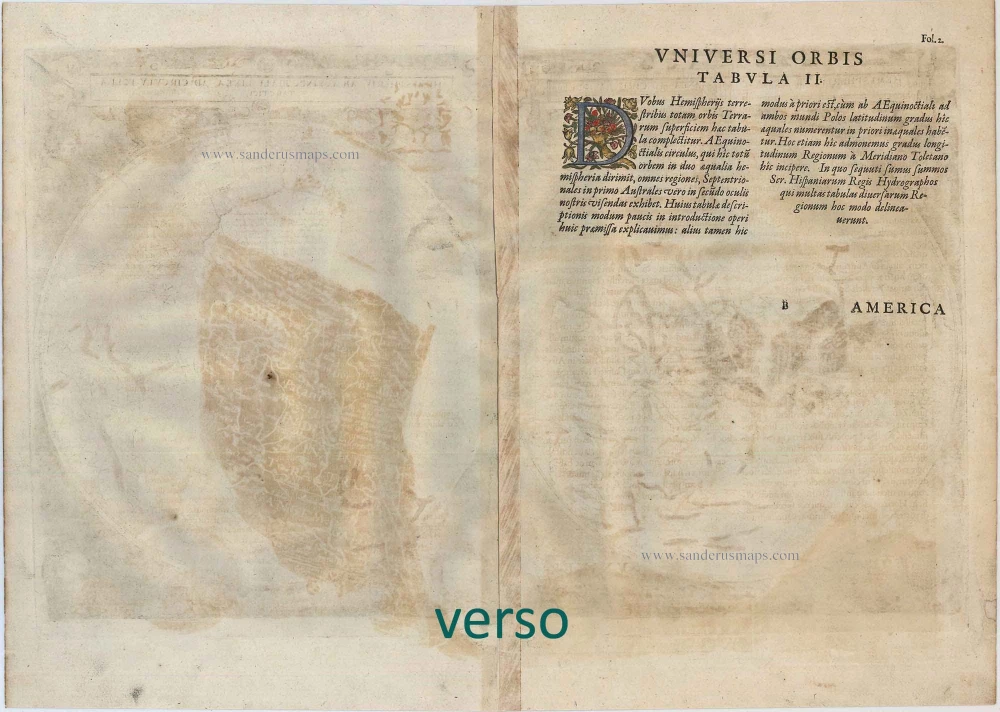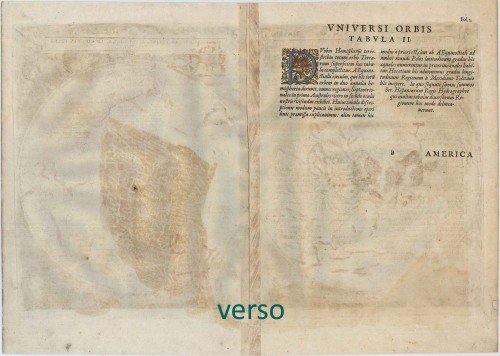Antique world map by C. de Jode, on the twin hemispherical polar projection 1593
"In 1578, Gerard de Jode published his Speculum Orbis Terrarum, an atlas aimed at competing with the Theatrum of Ortelius. However, the latter had first been issued in 1570 and had already built a commanding market presence, and so despite de Jode's longer-standing reputation, the atlas did not sell very well. Only a dozen or so examples have survived. Undeterred, he made plans for another expanded edition, and upon his death in 1591, it was taken on by his son Cornelis. The Speculum Orbis Terrae of 1593 likewise did not sell well and was never reissued. Although more examples than the first edition have survived, they are scarce. Many of de Jode's maps are judged to be superior to those of Ortelius in detail and style." (Burden)
"The map is an interesting adaptation of Guillaume Postel's 1581 world map with some curious features reminiscent of the large anonymous gores probably published in Antwerp in about 1587. Both maps have the same configuration for the northern coasts - the Gulf of Merosro in North America, the placing of Ter. d Labrador and Nova Zembla, and the odd junction of the eastern part of Asia with one of the large arctic masses. Japan is only a few degrees from the west coast of America. In the delineation of South Africa and South America, further features strongly suggest a common source." (Shirley)
Gerard and Cornelis de Jode
Gerard de Jode (Judaeus) (1508(?)-1591), a native of Nijmegen, began his career as a printer and engraver in Antwerp about 1550. He lived near the Bourse on the Catelijne Veste, or on "de Catte". He was in regular contact with Christoffel Plantin, to whom he sold many prints and maps. De Jode's business, which must have been a major one among Antwerp's many booksellers and printers, was represented at the Frankfurt fair, where de Jode bought maps that he later copied or re-sold. Most of the maps sold by De Jode have prototypes of Italian or German origin. Apart from his many separately published maps, Gerard de Jode is known for his atlas, Speculum Orbis Terrarum, published in 1578. Part of the engraving was done by himself, and part by brothers Jan and Lucas van Doetecum.
Gerard de Jode and Abraham Ortelius, who partly lived as map sellers, were competitors and only sometimes on good terms.
After the death of Gerard de Jode in 1591, the business was carried on by his widow, Pascale van Gelder and his son, Cornelis (1568-1600). More a publisher than an engraver, the latter reissued the Speculum in 1593, adding new maps and revising others.
Despite all its deficiencies, the Speculum must have had a good reputation. It is mentioned alongside Mercator's Atlas and Ortelius's Theatrum in Petrus Montanus's preface to the Germania Inferior of Pieter van den Keere.
Hemispheriu Ab Aequinoctiali Linea, Ad Circulu Poli Arctici; - Hemispherii Ab Aequinoctiali Linea, Ad Circulu Poli Atarctici.
Item Number: 19266 Authenticity Guarantee
Category: Antique maps > World
Antique world map by C. de Jode, on the twin hemispherical polar projection.
Title: Hemispheriu Ab Aequinoctiali Linea, Ad Circulu Poli Arctici; - Hemispherii Ab Aequinoctiali Linea, Ad Circulu Poli Atarctici.
Date of the first edition: 1593.
Date of this map: 1593.
Copper engraving, printed on paper.
Size (not including margins): 325 x 525mm (12.8 x 20.67 inches).
Verso: Latin text.
Condition: Superb bright old colouring, excellent.
Condition Rating: A.
From: Speculum Orbis Terrae. Antwerpen, G. De Jode, 1593. (Van der Krogt 3, 2:02)
"In 1578, Gerard de Jode published his Speculum Orbis Terrarum, an atlas aimed at competing with the Theatrum of Ortelius. However, the latter had first been issued in 1570 and had already built a commanding market presence, and so despite de Jode's longer-standing reputation, the atlas did not sell very well. Only a dozen or so examples have survived. Undeterred, he made plans for another expanded edition, and upon his death in 1591, it was taken on by his son Cornelis. The Speculum Orbis Terrae of 1593 likewise did not sell well and was never reissued. Although more examples than the first edition have survived, they are scarce. Many of de Jode's maps are judged to be superior to those of Ortelius in detail and style." (Burden)
"The map is an interesting adaptation of Guillaume Postel's 1581 world map with some curious features reminiscent of the large anonymous gores probably published in Antwerp in about 1587. Both maps have the same configuration for the northern coasts - the Gulf of Merosro in North America, the placing of Ter. d Labrador and Nova Zembla, and the odd junction of the eastern part of Asia with one of the large arctic masses. Japan is only a few degrees from the west coast of America. In the delineation of South Africa and South America, further features strongly suggest a common source." (Shirley)
Gerard and Cornelis de Jode
Gerard de Jode (Judaeus) (1508(?)-1591), a native of Nijmegen, began his career as a printer and engraver in Antwerp about 1550. He lived near the Bourse on the Catelijne Veste, or on "de Catte". He was in regular contact with Christoffel Plantin, to whom he sold many prints and maps. De Jode's business, which must have been a major one among Antwerp's many booksellers and printers, was represented at the Frankfurt fair, where de Jode bought maps that he later copied or re-sold. Most of the maps sold by De Jode have prototypes of Italian or German origin. Apart from his many separately published maps, Gerard de Jode is known for his atlas, Speculum Orbis Terrarum, published in 1578. Part of the engraving was done by himself, and part by brothers Jan and Lucas van Doetecum.
Gerard de Jode and Abraham Ortelius, who partly lived as map sellers, were competitors and only sometimes on good terms.
After the death of Gerard de Jode in 1591, the business was carried on by his widow, Pascale van Gelder and his son, Cornelis (1568-1600). More a publisher than an engraver, the latter reissued the Speculum in 1593, adding new maps and revising others.
Despite all its deficiencies, the Speculum must have had a good reputation. It is mentioned alongside Mercator's Atlas and Ortelius's Theatrum in Petrus Montanus's preface to the Germania Inferior of Pieter van den Keere.




